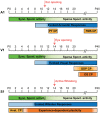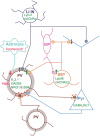The Role of Inhibitory Interneurons in Circuit Assembly and Refinement Across Sensory Cortices
- PMID: 35463203
- PMCID: PMC9021723
- DOI: 10.3389/fncir.2022.866999
The Role of Inhibitory Interneurons in Circuit Assembly and Refinement Across Sensory Cortices
Abstract
Sensory information is transduced into electrical signals in the periphery by specialized sensory organs, which relay this information to the thalamus and subsequently to cortical primary sensory areas. In the cortex, microcircuits constituted by interconnected pyramidal cells and inhibitory interneurons, distributed throughout the cortical column, form the basic processing units of sensory information underlying sensation. In the mouse, these circuits mature shortly after birth. In the first postnatal week cortical activity is characterized by highly synchronized spontaneous activity. While by the second postnatal week, spontaneous activity desynchronizes and sensory influx increases drastically upon eye opening, as well as with the onset of hearing and active whisking. This influx of sensory stimuli is fundamental for the maturation of functional properties and connectivity in neurons allocated to sensory cortices. In the subsequent developmental period, spanning the first five postnatal weeks, sensory circuits are malleable in response to sensory stimulation in the so-called critical periods. During these critical periods, which vary in timing and duration across sensory areas, perturbations in sensory experience can alter cortical connectivity, leading to long-lasting modifications in sensory processing. The recent advent of intersectional genetics, in vivo calcium imaging and single cell transcriptomics has aided the identification of circuit components in emergent networks. Multiple studies in recent years have sought a better understanding of how genetically-defined neuronal subtypes regulate circuit plasticity and maturation during development. In this review, we discuss the current literature focused on postnatal development and critical periods in the primary auditory (A1), visual (V1), and somatosensory (S1) cortices. We compare the developmental trajectory among the three sensory areas with a particular emphasis on interneuron function and the role of inhibitory circuits in cortical development and function.
Keywords: circuit; cortex; critical period; development; inhibition; interneuron; plasticity; sensory.
Copyright © 2022 Ferrer and De Marco García.
Conflict of interest statement
The authors declare that the research was conducted in the absence of any commercial or financial relationships that could be construed as a potential conflict of interest.
Figures



Similar articles
-
Cell Type-Specific Circuit Mapping Reveals the Presynaptic Connectivity of Developing Cortical Circuits.J Neurosci. 2016 Mar 16;36(11):3378-90. doi: 10.1523/JNEUROSCI.0375-15.2016. J Neurosci. 2016. PMID: 26985044 Free PMC article.
-
Inhibitory Units: An Organizing Nidus for Feature-Selective SubNetworks in Area V1.J Neurosci. 2019 Jun 19;39(25):4931-4944. doi: 10.1523/JNEUROSCI.2275-18.2019. Epub 2019 Apr 12. J Neurosci. 2019. PMID: 30979814 Free PMC article.
-
The Emergence of Network Activity Patterns in the Somatosensory Cortex - An Early Window to Autism Spectrum Disorders.Neuroscience. 2021 Jul 1;466:298-309. doi: 10.1016/j.neuroscience.2021.04.005. Epub 2021 Apr 19. Neuroscience. 2021. PMID: 33887384 Free PMC article. Review.
-
Interneuron-Targeted Disruption of SYNGAP1 Alters Sensory Representations in the Neocortex and Impairs Sensory Learning.J Neurosci. 2023 Aug 30;43(35):6212-6226. doi: 10.1523/JNEUROSCI.1997-22.2023. Epub 2023 Aug 9. J Neurosci. 2023. PMID: 37558489 Free PMC article.
-
Spontaneous activity in developing thalamic and cortical sensory networks.Neuron. 2021 Aug 18;109(16):2519-2534. doi: 10.1016/j.neuron.2021.06.026. Epub 2021 Jul 21. Neuron. 2021. PMID: 34293296 Free PMC article. Review.
Cited by
-
Molecular states underlying neuronal cell type development and plasticity in the postnatal whisker cortex.PLoS Biol. 2025 May 14;23(5):e3003176. doi: 10.1371/journal.pbio.3003176. eCollection 2025 May. PLoS Biol. 2025. PMID: 40367290 Free PMC article.
-
Functional diversities within neurons and astrocytes in the adult rat auditory cortex revealed by single-nucleus RNA sequencing.Sci Rep. 2024 Oct 25;14(1):25314. doi: 10.1038/s41598-024-74732-7. Sci Rep. 2024. PMID: 39455606 Free PMC article.
-
Molecular states underlying neuronal cell type development and plasticity in the whisker cortex.bioRxiv [Preprint]. 2024 Oct 7:2024.10.07.617106. doi: 10.1101/2024.10.07.617106. bioRxiv. 2024. Update in: PLoS Biol. 2025 May 14;23(5):e3003176. doi: 10.1371/journal.pbio.3003176. PMID: 39416021 Free PMC article. Updated. Preprint.
-
Experience Dependence of Alpha Rhythms and Neural Dynamics in the Mouse Visual Cortex.J Neurosci. 2024 Sep 18;44(38):e2011222024. doi: 10.1523/JNEUROSCI.2011-22.2024. J Neurosci. 2024. PMID: 39151954 Free PMC article.
-
Temporal manipulation of the Scn1a gene reveals its essential role in adult brain function.Brain. 2024 Apr 4;147(4):1216-1230. doi: 10.1093/brain/awad350. Brain. 2024. PMID: 37812819 Free PMC article.
References
Publication types
MeSH terms
Grants and funding
LinkOut - more resources
Full Text Sources
Other Literature Sources

